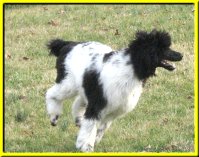
|
What is it? The American Kennel Club started the Canine Good Citizen Program® in 1989 as a means of rewarding dogs who were well-behaved companions at home and in the community. The goals of the CGC program are to teach responsible dog ownership to owners and to provide basic training and good manners to dogs. A key component of the CGC program is the 10-step CGC Test. All dogs (including purebreds and mixed breeds) who pass the CGC Test receive a certificate from the American Kennel Club. Item #1: Accept a Friendly Stranger This test demonstrates
that the dog will allow a friendly stranger to approach it and speak
to the Item
#2: Sit Politely for Petting This test demonstrates that the dog will allow a friendly stranger to touch it while it is out with its handler. The dog should sit at the handler's side as the evaluator approaches and begins to pet the dog on the head and body only. The dog may stand in place to accept petting. The dog must not show shyness or resentment. Item #3: Appearance and Grooming This test demonstrates
that the dog will welcome being groomed and examined and will permit
a stranger, such as a veterinarian, groomer or friend of the owner,
to do so. It also demonstrates the Item #4: Out for a Walk (Walking on a loose leash) This test demonstrates that the handler is in control of the dog. The dog may be on either side of the handler, whichever the handler prefers. There must be a left turn, a right turn, and an about turn, with at least one stop in between and another at the end. The dog need not be perfectly aligned with the handler and need not sit when the handler stops. Item #5: Walk Through a Crowd This test demonstrates
that the dog can move about politely in pedestrian traffic and is
under control in public places. The dog and handler walk around
and pass close to several people (at least three). The dog may show
some interest in the strangers, without appearing overexuberant,
shy or resentful. The handler may talk to the dog and encourage
or praise the dog throughout the test. The dog should not be straining
at the leash. Item #6: Sit and Down on Command/Staying in Place This test demonstrates that the dog has training, will respond to the handler's command to sit and down, and will remain in the place commanded by the handler (sit or down position, whichever the handler prefers). The handler may take a reasonable amount of time and use more than one command to make the dog sit and then down. When instructed by the evaluator, the handler tells the dog to stay and walks forward the length of a 20-ft. line. The dog must remain in place, but may change positions. Item #7: Come When Called This test demonstrates
that the dog will come when called by the handler. The handler will
walk 10-feet from the dog, turn to face the dog, and call the dog.
The handler may use encouragement to get the dog Item #8: Reaction to Another Dog This test demonstrates that the dog can behave politely around other dogs. Two handlers and their dogs approach each other from a distance of about 15-feet, stop, shake hands and exchange pleasantries, and continue moving. The dogs should show no more than a casual interest in each other. Item
#9: Reactions to Distractions This test demonstrates that the dog is confident at all times when faced with common distracting situations, such as the dropping of a large book or a jogger running in front of the dog. The dog may express a natural interest and curiosity and/or appear slightly startled, but should not panic, try to run away, show aggressiveness or bark. Item #10: Supervised Separation This test demonstrates
that a dog can be left with a trusted person, if necessary, and
will maintain its Why Do It? Earning the CGC award will ensure that your dog is a well-respected member of your community. The Canine Good Citizen award is one of the first AKC certificates your dog can own and CGC provides an excellent foundation for all other training. Some Therapy dog groups require the CGC as a prerequisite for therapy work. There are CGC neighborhoods and hiking trails, and a number of state legislatures have endorsed the CGC concept. Canine Good Citizen training is fun and useful. You'll find that training for the CGC award will help you establish a closer bond with your dog. Information
adapted from the American Kennel Club (www.akc.org) Angel says, "Thank you for training us to be Good Citizens!"
|
||
Kiss your children every day - today is gone, and tomorrow may never come.
 handler in a natural, everyday situation. The evaluator and
handler shake hands and exchange pleasantries. The dog must show
no sign of resentment or shyness, and must not break position or
try to go to the evaluator.
handler in a natural, everyday situation. The evaluator and
handler shake hands and exchange pleasantries. The dog must show
no sign of resentment or shyness, and must not break position or
try to go to the evaluator. owner's care, concern and sense
of responsibility. The evaluator inspects the dog, then combs or
brushes the dog, and lightly examines the ears and each front foot.
owner's care, concern and sense
of responsibility. The evaluator inspects the dog, then combs or
brushes the dog, and lightly examines the ears and each front foot.
 to come. Handlers
may choose to tell dogs to "stay" or "wait"
or they may simply walk away, giving no instructions to the dog
as the evaluator provides mild distractions (e.g., petting).
to come. Handlers
may choose to tell dogs to "stay" or "wait"
or they may simply walk away, giving no instructions to the dog
as the evaluator provides mild distractions (e.g., petting). training and good manners. Evaluators are encouraged
to say something like, "Would you like me to watch your dog?"
and then take hold of the dog's leash. The owner will go out of
sight for 3 minutes. The dog does not have to stay in position but
should not continually bark, whine, or pace unnecessarily, or show
anything stronger than mild agitation or nervousness.
training and good manners. Evaluators are encouraged
to say something like, "Would you like me to watch your dog?"
and then take hold of the dog's leash. The owner will go out of
sight for 3 minutes. The dog does not have to stay in position but
should not continually bark, whine, or pace unnecessarily, or show
anything stronger than mild agitation or nervousness.